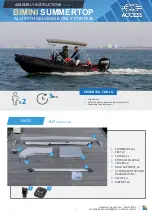
6 – HAZARDS ANALYSIS
Analysis of hazards that may occur during normal working, installation and maintenance. In line with what is required by
PED Directive 2014/68/UE the manufacturer must follow the principles set out below in the following order to arrive at
the most appropriate solution:
a) eliminate or reduce hazards as far as is reasonably practicable
b) apply appropriate protection measures against hazards which cannot be eliminated
c) where appropriate, inform users of residual hazards
CAUSE
Over-pressure (more than the maximum allowable pressure PS)
EFFECT
Breaking of pressure equipment, stress crack, permanent deformations.
RISK
Discharge of metallic parts, leakage of fluid.
SOLUTION
a) The pressure equipment is properly designed taking in account appropriate safety
coefficients assured by the calculation method.
b) The plant must be equipped with the appropriate safety valve; the maximum allowable
pressure PS is written on the identification plate.
CAUSE
Over-temperature (more than the maximum allowable temperature TS)
EFFECT
Internal over-pressures.
RISK
Breaking or deformation of pressure equipment, leakage of fluid.
SOLUTION
a) The plant must be equipped with appropriate control devices against over-temperature.
b) The maximum allowable temperature TS is written in the identification plate.
CAUSE
Reaction to external stresses
EFFECT
Deformation, structural settling.
RISK
Discharge of metallic parts, leakage of fluid.
SOLUTION
a) External loads cannot be applied to the pressure equipment; the installer must take
appropriate special measures to protect the pressure equipment from external stresses.
b) See prescriptions at point 1.
c) The installer must ensure the pressure equipment is fitted with suitable accessories to
meet damage-limitation requirements in the event of external fire.
CAUSE Working
temperature
EFFECT
High surface temperature.
RISK
Burns.
SOLUTION
a) Installation in safe and/or protected places and/or insulation of the equipment.
b) Instructions must be affixed to the equipment and also refer to hazards arising from
dangerous surface temperatures.
c) Insulation for personal protection.
CAUSE
Installation and/or use not in accordance with directions and/or as laid down by law
EFFECT
Non correct assembling of the pressure equipment, breaking of pressure equipment.
RISK
Bad working of the plant, leakage of fluid.
SOLUTION
a) The installer and/or the user must take the necessary steps to comply with the rules as
laid down by law and check the compatibility with the used fluids.
b) See prescriptions at point 1.
CAUSE
Maintenance of the equipment with the plant under pressure
EFFECT
Incorrect maintenance.
RISK
Bad working of the plant, danger of discharge of metallic parts, danger of leakage of fluid.
SOLUTION
a) The maintenance of the equipment must be carried out with the equipment at
atmospheric pressure.
b) The equipment must be without hydrostatic pressure.
c) The fluids of the equipment must be intercepted.
CAUSE
External loads on the connections
EFFECT
Deformation, structural settling.
RISK
Breaking or deformation of pressure equipment, leakage of fluid.
SOLUTION
a) Suitable support must be given to upper pipeworks for upper external loads.
About lower external loads (on the lower pipeworks) do not applicate traction forces.
b) Local stresses are shown at pages 4/5. Do not overtake the values.
c) See anyway prescriptions at point 2.2.
8






























